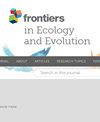Frontiers | Plant-insect interactions in the mid-Cretaceous paleotropical El Chango Lagerstätte (Cintalapa Fm., Mexico)-patterns of herbivory during the Angiosperm Terrestrial Revolution
IF 2.4
3区 环境科学与生态学
Q2 ECOLOGY
引用次数: 0
Abstract
Plants and insects are two of the more diverse and abundant organisms in terrestrial ecosystems. The fossil record of plant-insect interactions offers crucial insights into the coevolutionary dynamics between these groups, shedding light on the intricate relationships that have shaped terrestrial ecosystems. The study of fossil interactions is especially relevant in mid-Cretaceous ecosystems, a time of dramatic changes in the composition of floras and, consequently, in plant-insect relationships. Here, we describe the first suite of plant-insect interactions from the mid-Cretaceous of Mexico. We studied 554 plant fossils from the El Chango Lagerstätte (Cintalapa Formation, Chiapas, Mexico), including vegetative (leaves) and reproductive structures (fruits and seeds). The flora was dominated by gymnosperms (89.3%) followed by angiosperms (10.7%); other groups, such as pteridophytes and bryophytes, were absent. In total, 5.4% of the plant specimens hosted some damage. Angiosperms (all broad-leafed forms), despite being much less common than gymnosperms, expressed more evidence of damage by herbivores (35.6% of specimens damaged). In contrast, the narrow-leafed gymnosperms, the dominant group in the flora, hosted a much lower proportion of herbivory damage (1.8% of specimens damaged). The diversity of damage types (DTs) was relatively low: 14 DTs were identified, corresponding to seven FFGs, including margin feeding, hole feeding, surface feeding, piercing and sucking, oviposition, galling, and mining. Comparison with the other mid-Cretaceous plant-insect assemblages reveals a similar richness of DTs for angiosperms but a lower richness and diversity of DTs on gymnosperms from El Chango. These results indicate preferential herbivory on angiosperms (rather than on the available gymnosperms in the assemblage) by terrestrial arthropods during a period of major changes in the structure of terrestrial ecosystems. However, it is challenging to resolve whether this apparent preference is because insects particularly targeted angiosperms or if the herbivores simply targeted broad leaves in general, since most of the available gymnosperms from El Chango are scale-leafed forms.白垩纪中期古热带埃尔昌戈拉格斯塔特(墨西哥辛塔拉帕地层)植物与昆虫之间的相互作用--被子植物陆地革命期间的食草模式
植物和昆虫是陆地生态系统中种类较多、数量较大的两种生物。植物-昆虫相互作用的化石记录为了解这两个类群之间的共同进化动态提供了重要线索,揭示了塑造陆地生态系统的错综复杂的关系。在白垩纪中期的生态系统中,植物群的组成发生了巨大变化,植物与昆虫之间的关系也随之发生了巨大变化,因此对化石相互作用的研究尤为重要。在这里,我们描述了墨西哥中白垩世的第一套植物-昆虫相互作用化石。我们研究了来自墨西哥恰帕斯州辛塔拉帕地层 El Chango Lagerstätte 的 554 件植物化石,包括植物(叶片)和生殖结构(果实和种子)。植物群以裸子植物为主(89.3%),其次是被子植物(10.7%);其他植物群,如翼手目植物和叶绿体植物,则不存在。总共有 5.4% 的植物标本受到了一些损害。被子植物(所有阔叶形式)尽管比裸子植物少得多,但却有更多证据表明受到了食草动物的破坏(35.6%的标本受到了破坏)。相比之下,植物区系中占主导地位的窄叶裸子植物遭受草食动物破坏的比例要低得多(1.8%的标本被破坏)。损害类型(DTs)的多样性相对较低:共发现 14 种 DTs,与 7 种 FFGs 相对应,包括边缘取食、孔取食、表面取食、穿刺和吸吮、产卵、咬合和采矿。与白垩纪中期的其他植物-昆虫组合比较发现,埃尔昌戈地区被子植物的 DTs 种类丰富程度相似,但裸子植物的 DTs 种类丰富程度和多样性较低。这些结果表明,在陆地生态系统结构发生重大变化的时期,陆生节肢动物优先选择被子植物(而不是组合中的裸子植物)作为食草动物。然而,由于埃尔昌戈现有的大多数裸子植物都是鳞叶植物,因此很难确定这种明显的偏好是因为昆虫特别针对被子植物,还是因为食草动物只是针对一般的阔叶植物。
本文章由计算机程序翻译,如有差异,请以英文原文为准。
求助全文
约1分钟内获得全文
求助全文
来源期刊

Frontiers in Ecology and Evolution
Environmental Science-Ecology
CiteScore
4.00
自引率
6.70%
发文量
1143
审稿时长
12 weeks
期刊介绍:
Frontiers in Ecology and Evolution publishes rigorously peer-reviewed research across fundamental and applied sciences, to provide ecological and evolutionary insights into our natural and anthropogenic world, and how it should best be managed. Field Chief Editor Mark A. Elgar at the University of Melbourne is supported by an outstanding Editorial Board of international researchers. This multidisciplinary open-access journal is at the forefront of disseminating and communicating scientific knowledge and impactful discoveries to researchers, academics and the public worldwide.
Eminent biologist and theist Theodosius Dobzhansky’s astute observation that “Nothing in biology makes sense except in the light of evolution” has arguably even broader relevance now than when it was first penned in The American Biology Teacher in 1973. One could similarly argue that not much in evolution makes sense without recourse to ecological concepts: understanding diversity — from microbial adaptations to species assemblages — requires insights from both ecological and evolutionary disciplines. Nowadays, technological developments from other fields allow us to address unprecedented ecological and evolutionary questions of astonishing detail, impressive breadth and compelling inference.
The specialty sections of Frontiers in Ecology and Evolution will publish, under a single platform, contemporary, rigorous research, reviews, opinions, and commentaries that cover the spectrum of ecological and evolutionary inquiry, both fundamental and applied. Articles are peer-reviewed according to the Frontiers review guidelines, which evaluate manuscripts on objective editorial criteria. Through this unique, Frontiers platform for open-access publishing and research networking, Frontiers in Ecology and Evolution aims to provide colleagues and the broader community with ecological and evolutionary insights into our natural and anthropogenic world, and how it might best be managed.
 求助内容:
求助内容: 应助结果提醒方式:
应助结果提醒方式:


